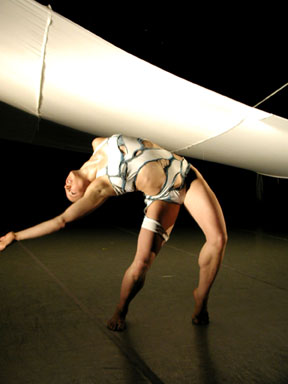Controlled Complexity
LEVYdance
Dance Place, Washington, DC
Saturday, October 4, 2003
by George Jackson
© 2003
The audience for LEVYdance's visit differed from the one which had come to Dance Place's Washington women's program a week earlier. This was a younger public, college age and casually dressed. Women and men were about equal in number, and the ambience was easy, not competitive at all. I was there the second of the two nights but was told that the opening night crowd was similar, a bit more charged perhaps because it was the opening. This engagement wasn't the San Francisco Bay Area based Benjamin Levy's DC debut. He and his work, though not his full company, have been seen here before and already had attracted something of a following.
 Of
the program's three pieces it was the closing work, Temporal Rust
that was the most ambitious because of its set, designer costumes and
use of dancers as dancers and as sculptures. The cast of five was still
as statues at the beginning and end of the piece, not because Levy ran
out of movement ideas but quite the contrary perhaps, because he wanted
to show that his many dance themes include stillness and so he integrated
the dancers into the dramatically lit set. For costuming, Wendy Sparks
had cut apertures into the tight-fitting swim togs worn by the four women
and one man. There were so many openings in the apparel that the remaining
bands and patches of material, which had dark liner markings, looked like
bandages. The dancers wore these bandages with chic but, more importantly,
one could see anatomy at work in ways which the looser, fuller costuming
of the other pieces did not permit. Levy is very aware of body parts and
how they are joined. He explores the degrees of movement freedom at the
major joints, but this is just one component of a choreography that has
welcome complexity.
Of
the program's three pieces it was the closing work, Temporal Rust
that was the most ambitious because of its set, designer costumes and
use of dancers as dancers and as sculptures. The cast of five was still
as statues at the beginning and end of the piece, not because Levy ran
out of movement ideas but quite the contrary perhaps, because he wanted
to show that his many dance themes include stillness and so he integrated
the dancers into the dramatically lit set. For costuming, Wendy Sparks
had cut apertures into the tight-fitting swim togs worn by the four women
and one man. There were so many openings in the apparel that the remaining
bands and patches of material, which had dark liner markings, looked like
bandages. The dancers wore these bandages with chic but, more importantly,
one could see anatomy at work in ways which the looser, fuller costuming
of the other pieces did not permit. Levy is very aware of body parts and
how they are joined. He explores the degrees of movement freedom at the
major joints, but this is just one component of a choreography that has
welcome complexity.
The two major objects in the set (designed by Gregory Emetaz and built by Alf Pollard) are a trampolin canvas and a waterfall. At first, the canvas is stretched above the stage like a tent cover with several peaks. When it is lowered, dancers move under it as well as on it. Human motion generates tensions in the canvas and these amplify the actual dancing but also restrict it like a corset. The waterfall's effect on movement is less significant, but its splash mixes pleasingly with Desdemona Chiang's sound collage.
Levy presents his dancers as soloists, as members of an ensemble and in between. He generates complexity almost everywhere but controls it best in duos. His ensembles, no matter how cleverly he subdivides them, tend to be fussy. They were very fussy at the beginning of pOrtal, which opened the program, although he ended this piece with unison work that, coming suddenly as it did, seemed blunt. Fine duos with novel yet not forced floorwork, lifts, contact sequences and an ample supply of other tactics are found in Temporal Rust, but everything in the program's middle work, the men's duo Falling After Too, fell into place beautifully. Levy danced it, not with Darrin Michael Wright, his co-choreographer for Falling, but with his company's male soloist, Christopher Hojin Lee. The two stood facing each other for some time, then reached out to touch and hold one another testingly, briefly. Grabbing, pushing, pulling occured rapidly, mutually with changing dynamics. The men played arm games, being simultaneously puppet and puppeteer. They split from one another in order to scoot and roll across the floor separately but mostly in parallel. The atmosphere in which they moved was music—a piano score by Yann Tiersen that seemed modern in tonality but romantic in phrasing. Sometimes the two repeated maneuvers tried before but with different emphases. The duet ends as it began, except that between the two a bond had grown.
All the dancers—Lily Dwyer, Cambria Garell, Lauren Slater, Patricia West, Levy and Lee—are fleet and, particularly in the upper body, agile. They have to be to meet the choreography's demands. Lee, appearing in all three pieces, had a workout but remained reliable to the end. Levy makes the five dancers seem many more. What would he do with a really big cast?
Photo:
Lily Dwyer in Benjamin Levy's Temporal Rust
Credit: Desdemona Chiang
Originally
published:
www.danceviewtimes.com
Volume 1, Number 2
October 6, 2003
©2003
George
Jackson
|
|